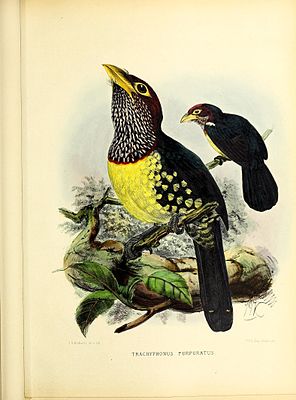Yellow-billed bearded bird
| Yellow-billed bearded bird | ||||||||||||
|---|---|---|---|---|---|---|---|---|---|---|---|---|

Yellow-billed bearded bird ( Trachyphonus purpuratus ) |
||||||||||||
| Systematics | ||||||||||||
|
||||||||||||
| Scientific name | ||||||||||||
| Trachyphonus purpuratus | ||||||||||||
| J. Verreaux & E. Verreaux , 1851 |
The yellow-billed barbet ( Trachyphonus purpuratus ) is a bird art from the family of the African barbets. The species occurs in Africa on both sides of the equator. Several subspecies are distinguished. The IUCN classifies the yellow-billed bearded bird as not endangered.
Appearance
The males of the nominate form have a wing length of 10.2 to 11.3 centimeters. The tail length is 9.2 to 10.2 centimeters. The beak reaches a length of 2.6 to 2.9 centimeters. The weight varies widely and is between 75 and 109 grams. Females have similar body measurements. There is no noticeable sexual dimorphism .
In both sexes, the region from the forehead to the middle of the skull is dull red. The back of the head, the nape of the neck and the sides of the neck are glossy blue-black. The upper side of the body is black-brown, freshly moulted plumage has a blackish sheen. The control springs are black. The lanceolate feathers on the chin and anterior throat are brown at the base, then black, and turn red towards the tip. The chest, belly and under tail-coverts are yellow. The sides of the body are striped black and yellow.
The beak is strong, its color varies from bright yellow to orange. The feathered region around the eyes is bright yellow in the nominate form, the eyes are red to orange-red or red-brown. The feet and legs are gray to black. In the subspecies T. p. goffinii and T. p. togoensis is the featherless region around the eyes gray-black to gray-blue. The subspecies T. p. elgonensis is similar to the nominate form in this characteristic, but is a little reddish overall.
The yellow-billed bearded bird can be distinguished from the double-toothed bearded bird of the same size by its yellow belly. It is longer-tailed than the spotted bearded bird and the yellow spotted bearded bird . These two species also have black beaks.
Distribution area
The yellow-billed bearded bird is found in West Africa. Its distribution area extends along the west coast of Sierra Leone over southern Guinea to southern Nigeria. In the east, the distribution area extends over the south of Cameroon, the south of the Central African Republic and the south of Sudan to western Kenya. The southern limit of distribution is the north of Angola, the south of the People's Republic of the Congo as well as Burundi and the south of Uganda. The yellow-billed bearded bird occurs predominantly in the lowlands. In West Africa it still lives at altitudes of up to 1300 meters and in western Kenya it occurs up to 2,800 meters.
Way of life
The habitat of the yellow-billed bearded bird is the dense undergrowth in primary forests . It also uses older secondary forests , forests along rivers and tree-lined cultivated land if this is adjacent to forest. Its activities are usually limited to a region up to a maximum of ten meters above the ground. It is generally an inconspicuous bird that looks for food alone or in pairs. Its diet includes insects and fruits. He aggressively defends the immediate region around his nesting hole and also asserts himself against the black- bearded birds that breed in colonies . Attacks on the Diadem-Bartvogel and Bülbüls are also documented.
The nest hole is created in a dead branch or tree trunk and is usually between two and eight meters above the ground. The breeding season varies with the latitude. The clutch consists of two to four eggs. These are white-skinned. The breeding season is not known. Nestlings call very often and are fed four to 14 times an hour. Nestling foods include berries, fruits, snails and insects. The duration of the nestling period is not known.
supporting documents
literature
- Lester L. Short, Jennifer FM Horne: Toucans, Barbets and Honeyguides - Ramphastidae, Capitonidae and Indicatoridae. Oxford University Press, Oxford 2001, ISBN 0-19-854666-1 .
Single receipts
- ↑ Short et al., P. 116.
- ↑ Short et al., Color plate 6.
- ↑ Short et al., P. 116 and p. 117.
- ↑ Short et al., P. 118.
- ↑ Short et al., P. 118.
Web link
- Trachyphonus purpuratus inthe IUCN 2013 Red List of Threatened Species . Listed by: BirdLife International, 2012. Retrieved February 2, 2014.